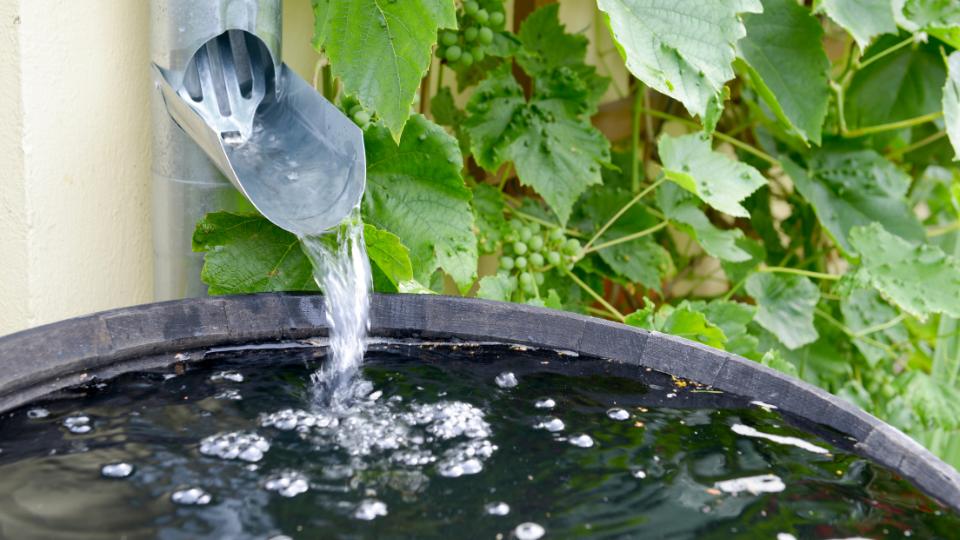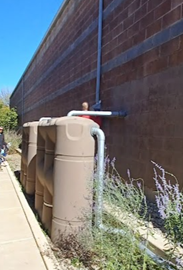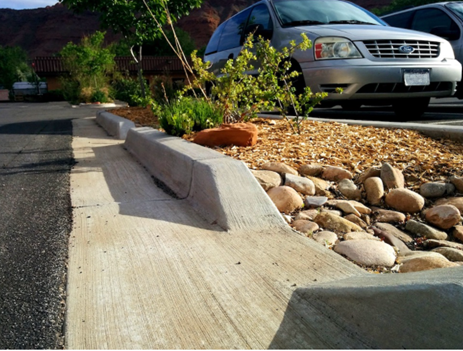Using Non-traditional Water Sources in the Landscape

Utah is the second-driest state in the nation but has an average per capita water use of 169 gallons per day. This is far from the 82 gallons per capita U.S. average. In addition, Utahns also use approximately 75% of their household water for outdoor irrigation, again 45% more than the U.S. average. One might argue that commercial and household water use is only around 15-20% of water, so any reduction in household and landscape water use will be insignificant. However, agricultural water is usually non-potable, but landscape and household irrigation is usually potable water. Potable water is treated and filtered, and any savings in potable water can directly be used for drinking purposes while the same can’t be said for agricultural water. Hence, any effort made to reduce household water is worth every gallon.
Water Generated From Air Conditioners – AC Condensate
A 2-ton air conditioner (AC) can generate anywhere from 20 to 25 gallons of water per day during summer. In comparison, a hydrangea plant will need around 2 gallons of water on a hot summer day. An online calculator created by Building Green can be used to estimate the approximate amount of water generated by an AC system.
Water from an AC is neutral in pH with total dissolved salts from 15 to 100 ppm and EC of 0 to 0.2 dS/m and is an excellent source of irrigation. It might even be of superior quality compared to secondary or even domestic water in Utah.
How to Collect AC Condensate
To collect AC condensate, locate the condensate outlet of the system and connect a pipe to the water outlet of the air conditioning system. The pipe can then be connected to a storage tank or rain barrel. Remember to work with gravity if feasible. You do not need any filters or purifiers as the water is very clean. Water straight out of the condenser is very cold, storage may also be necessary to raise water temperature before irrigating. Also, as the water has minimal impurities, it may be slightly corrosive to metal long-term; it is a good idea to use plastic pipes. In rare events, water from AC condensates may contain Legionella spp. which may cause Legionnaires’ disease. Therefore, using drip irrigation to avoid spraying of particles would be a safer way to irrigate plants. Once the water is in the soil, Legionella spp. will not be a problem.
Rain Gardens

Usually, people view rainwater as something that must be removed from the housing premises; however, that practice will reduce water storage in soil and increase environmental concerns. Instead, we should treat rainwater as an asset and aim to retain and use it as a free resource. Rainwater can be retained beneficially by using green infrastructure such as rain gardens.
A rain garden is a passive system of collecting rainwater by creating a depression in an existing landscape usually at the lowest lying zone of the property. Rain gardens recharge ground water, increase soil moisture, reduce pollutants, reduce stormwater runoff and lower heat-island effect. Using rain barrels is an active form of collecting rain water, which is described in this fact sheet. The core principle of the rain garden is to slow the water down, spread it out, and allow it to infiltrate.
How to Build a Rain Garden
Rain gardens can be built almost anywhere, such as houses, malls, parking strips, and parking lots. Rain gardens usually receive water from the property as rainfall or capture rainwater off the property by structure such as roadside sideway depressions. Rain gardens usually should have an inlet or channel which guides rainwater to the rain garden. The inlet may be single or multiple depending upon the amount of water collected. After the inlet, there is a forebay, which is an obstruction to stop large debris from flowing to the rain garden. Forebays are common in rain gardens collecting water from roads and highways but may not be necessary if the water is only collected from the same property. The major component of a rain garden is filter media, which is either permeable surfaces, rocks, pebbles, mulches or plants or a combination of all of these. Filter media helps rain gardens to retain, use, and infiltrate rainwater. It also purifies water before infiltration by removing pollutants.

Rain gardens should be leveled, and the bottom must be flat. Rain gardens may need a few years of irrigation to establish vegetation; however, once the vegetation is established you don’t need to irrigate (except in extreme drought conditions). Rain gardens are deeper at the center; therefore, plant high water use plants at the center. Use moderate moisture-loving plants on the edges and curbs. Native plants should be selected to increase plant survival; however, you may need to add or remove plants to establish a stable ecosystem in the first few years. If your rain garden receives water from roads and sidewalks, consider selecting salt-tolerant plants.
Rain gardens should be constructed at least 10 feet away from a building and should not be over utility lines and septic tanks. Rain gardens should also have an overflow system that guides rain water to an appropriate drainage channel. There is no specific type of soil mixture for creating rain gardens. Instead, just mixing the top few inches of soil should work well. Rain gardens require minimal maintenance; however, you might need to rake 1 to 2 inches of sediments annually and perform regular weeding.
Runoff Water/Irrigation Return Flow
Irrigation water in a nursery, landscape, and home usually creates runoff. The quality of irrigation return flow (IRF) such as pH, dissolve oxygen, salinity, turbidity, and EC are well within range for irrigation. However, it might have high amounts of nutrients and pesticides which may be good for plants but are detrimental to the environment. An option to curb this runoff is to collect water in an area-appropriate retention pond and reuse it as a source of irrigation. This strategy might be feasible for larger landscapes and can also be incorporated into smaller landscapes depending on the runoff amount. The retention pond may also aid in stormwater management. Retention ponds act basically like a rain garden but without any water infiltration.
How to Collect Runoff Water Using a Retention Pond

Identify low-lying areas in your landscape and dig a circular retention pond that is at least three feet deep. A pond usually should be able to retain runoff over a 24-hour period with a 25-year intensity storm. Line the pond with a 0.5-3.0 m thick plastic liner (that has a 20-year or longer life guarantee) or 45 mil Ethylene Propylene Diene Monomer (EPDM) to reduce filtration and seepage. Design an overflow drainage on the lowest side of the pond in the case of flooding.
Once you have created a retention pond and collected enough water, you may use a pump to directly pump water to irrigate plants via irrigation systems. A deeper pond
might have thermal stratification, so a pump should include a t-valve to mix water when applying and a filter to remove sediments before the water reaches emitters. Retention ponds can reduce pesticide concentrations from IRF and reduce plant pathogens, but water treatment may be necessary if the pathogen load in ponds is very high.
A retention pond might be a good source of irrigation water in areas generating high runoff and may also act as a stormwater management plan and rainwater harvesting option in areas with infrequent and intense rainfall. Retention ponds might not be feasible for smaller landscapes and low runoff sites.
Gray Water
Gray water is the waste water generated from the household that does not possess health risks. Water from toilets, dishwashers, or kitchen sinks are not considered gray water. Gray water has a huge potential to stand out as an alternate water source for landscape as described in this fact sheet by USU https://digitalcommons.usu.edu/cgi/viewcontent.cgi?article=1804&context=extension_curall.
Authors
Related Research


 Utah 4-H & Youth
Utah 4-H & Youth



